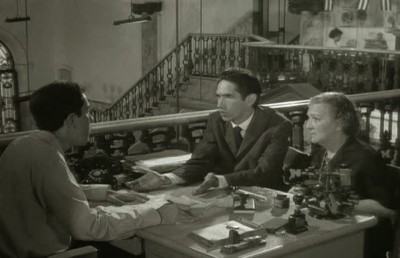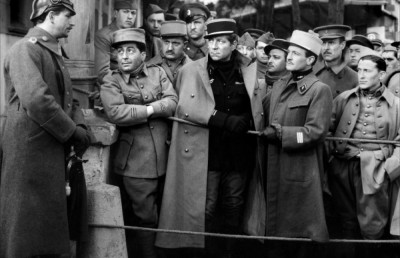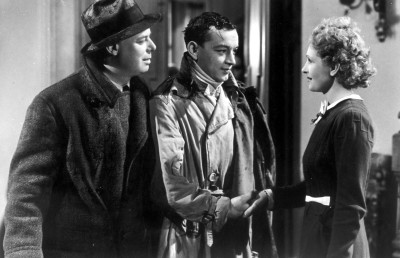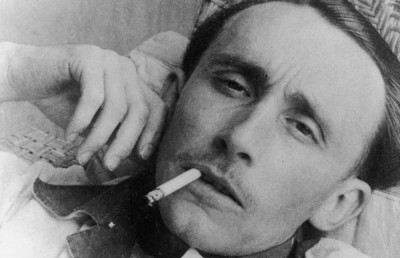Eisenstein on his audiovisual collaboration with Prokofiev
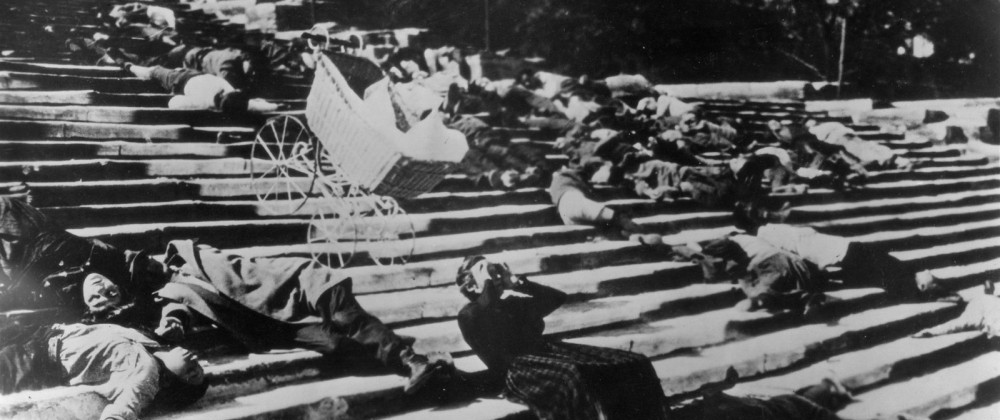
Eisenstein saw cinema as a collaborative means of expression, and it was his practice of collaboration, involving a certain amount of “give and take,” which proved to be so fruitful in his work with Prokofiev on his first completed audiovisual films Alexander Nevsky and Ivan the Terrible. [1] When Prokofiev later wrote about his collaboration with Eisenstein, he mentioned his great respect for music, to the extent that the director would be prepared to make necessary adjustments to his montage to “preserve the integrity of the musical fragment.” [2]
According to Eisenstein, he and Prokofiev would always “bargain” for a long time before it was decided who should be first to make the next decisive audiovisual step. This would be a choice between the composer having to write the music having seen the relevant section of unedited film, or to compose it once Eisenstein had already edited it. With respect to the first choice, it would be up to the film director to develop the montage from Prokofiev’s existing score; with the second option, the principal artistic choices, in the form of his film montage, would already have been made by Eisenstein. With the latter choice it was then up to the composer to create an appropriate construction using the available techniques of musical composition, based on the director’s “architectural” plan. On the other hand, the first choice implied for Prokofiev what Eisenstein thought of as a fundamental creative problem, the responsibility for determining the developing rhythmic structure of the section. This option involved the composer drawing up the “architectural” plan itself, which would then determine how the film director’s audiovisual montage would operate. Eisenstein describes in detail the complexities of what he refers to as the internal mechanisms of this procedure. [3] When he is confronted with a recording of Prokofiev’s score, and he has to create a film montage to match it, these are the steps he outlines:
1. You must have in your memory a mental record of all the unedited film, the “plastic” material which can at any point be manipulated and transformed.
2. Listen again and again to the recorded music, until the moment arises when you can imagine a series of images which could correspond with the music, or a section of the music which could correspond with an imagined filmed sequence. [4]
These correspondences can be of various types:
-a texture of an object or a landscape which can be matched with a timbre in the music;
-the possibility of synchronising a series of close-ups with a certain rhythmic pattern in the music;
-the matching of the music with a corresponding section of visual representation, producing an internal harmony, inexpressible in rational terms. [5]
This list of audiovisual correspondences is necessarily limited, as the combinations depend on a vast range of variables, both in terms of the content of the music and of the film, and many other factors relating to the overall creative intention. For Eisenstein there are other difficulties at this point in the process of combination:
-the visual part of the combination is as yet chaotically unrealised;
-what Eisenstein describes as a “spirit of combination” which hovers above a “primeval chaos of representation” is nevertheless dependent on the laws of musical development which are evident in the recording of the score;
-the mind of the film director has to leap from any part of his unedited film to any other part of it, in order to mentally rehearse what film montage would correspond with each section of the music;
-the montage of the film also has to follow its own laws, otherwise it will not work visually. [6]
Eisenstein notes at this point how this audiovisual process was very like the method he used to create the montage for his pre-sound films. The basic difference was that instead of selecting pieces of montage to a pre-existing recording of music, he had in his mind what he describes as a “musical score” or “inner melody” to which he edited his shots. He explains that this melody is frequently so powerful that at times the entire rhythm of his actions is determined in advance during the days when he is editing scenes to correspond to these sounds. He goes on to give examples of the type of distracted behaviour he experienced when he was editing very different sections of The Battleship Potemkin. When editing the “Mist” and “Mourning for Vakulinchuk” sections, he would carry out everyday activities in what he describes as a “‘wilting’ rhythm,” in marked contrast to the abrupt and aggressive behaviour he exhibited in daily activities when he was editing the sequence of the massacre on the Odessa Steps. [7] This is very similar to the synaesthetic behaviour Eisenstein described when he was absorbed in “some abstract problem.” [8] Here there is an analogous transfer and superimposition of one set of perceptions and emotions to another unrelated set, in a seemingly arbitrary manner. Eisenstein gives an example of the actor Michael Chekhov, who was acting the part of a distracted man in the theatre in the evenings: from the morning and throughout the day at home he would fall over chairs, upset cups and break dishes. [9]
Eisenstein confesses that he does not really know how a composer’s inner compositional processes work, but he does attempt to elucidate some of what he thinks took place in Prokofiev’s mind during their audiovisual collaborations. What particularly impressed him about Prokofiev was his ability to capture, after watching a scene from the film only two or three times, its emotional effect, rhythm and structure. As a result of this gift, the composer could provide the very next day a fully-scored “musical equivalent of the visual representation.” As an example of Prokofiev’s audiovisual talent, Eisenstein describes how the composer had achieved a complex “interweaving of accents of action and music” in his score for the episode from Ivan the Terrible where Ivan implores the boyars for their support. He also noticed that Prokofiev had only rarely synchronised the visual accents with the musical accents, and that these joint accents were solely conditioned by the montage and by the development of the action during this particular scene. [10]
How did Prokofiev achieve so rapidly such a remarkably flawless audiovisual combination, which needed no amendments, either to the film or to the music? Eisenstein found the answer to this question in a surprisingly mundane manner, when he remembered how the composer had articulated his new telephone number when he had called it out to him. He had subsequently realised that Prokofiev’s voice had closely followed the pattern of the figures in his new number, in terms of dynamics (soft to loud), and the rhythm of the combined names of the numbers announced in an emotionally charged way. Eisenstein demonstrates Prokofiev’s “performance” of his new number, k 5-10-20, extension 35, by notating it in the typographical manner of the poets Velimir Khlebnikov or Tristan Tzara:
K5! 10!! 20!!! Extension 30!!! 5. [11]
The composer had evidently recognised the pattern of the increasing size of the first four numbers, reaching a musical climax on the figure 30, before the final number which repeats the first one, at the same volume level. This was a musician’s way of remembering his new telephone number. For Eisenstein this mnemonic technique is the key to Prokofiev’s ability to translate his perception of visual representation directly into a musical form. [12] He also refers to it as his talent for “creating images in music.” [13] Eisenstein breaks down what he believes to be the composer’s audiovisual compositional technique in this manner:
1. the finding of a pattern in what first appears to be a “primeval chaos of representation;”
2. the addition of an emotional interpretation to this found pattern. [14]
The second part of this audiovisual process then leads to the third action, what Eisenstein describes as the way in which the audiovisual formula is “mastered sensually.” This is the way in which Prokofiev translates the telephone number into an intonational pattern, which Eisenstein calls the melody of the “tune” of speech, one of the foundations of music. Therefore, in the third and final part of this audiovisual compositional process, the “formula,” which is the emotional interpretation of the found pattern, becomes translated by the craft of the composer into a piece of music – it is “mastered sensually.” For Eisenstein the mnemonic process is what is common to both Prokofiev’s memorisation of his new number, and his ability to translate images into music: a person’s mnemonic method is largely the key to that individual’s thought processes. He acknowledges that mnemonic techniques can be very varied, from a straightforward process of association, to something more compositional and complex. As an example, Eisenstein mentions how a series of words to be memorised is linked through action and content to create a “concrete picture” in one’s memory. [15] This statement could be understood as a process which is analogous to Prokofiev’s audiovisual compositional technique. The series of words corresponds to the series of images in an edited or unedited film. This series is then connected by a found pattern, which Prokofiev translates into a piece of music, the aural equivalent of Eisenstein’s “concrete picture.” Whether the associational process features images, words or music, the compositional technique, involving a combination of memory, emotion and transferral from one medium to another, is the same.
Eisenstein gives a specific example of how Prokofiev demonstrated to him an aspect of his audiovisual composition technique. The composer showed him the audiovisual relationships he had featured in a song about the sea, which was being performed for a recording which was to have been included in Ivan the Terrible. Prokofiev pointed out to him the parts in the music which he had connected to various characteristics of the sea: waves, a splash, the sea’s depth, the feeling of a tempest. As these elements were not all featured in the score at the same time, Eisenstein compared this form of depiction with various camera set-ups, used to film, say, a fortress. If this building were only to be filmed “head-on,” it would not appear in a fully three-dimensional way. In addition this single image of the fortress would lack the emotion which would be expressed by the choice of the various camera angles used to depict it. [16] Eisenstein describes Prokofiev’s audiovisual composition method in terms of “tonal camera angles”: “having grasped the structural secret of a phenomenon, he clothes it in the tonal camera angles of instrumentation, making it sparkle with shifts of timbre, and forces the whole inflexible structure to blossom forth in the emotional fullness of orchestration.” [17]
Eisenstein also describes his observation of Prokofiev when the composer was working on the first step of his audiovisual technique: the finding of a pattern in what first appears to be the “primeval chaos of representation” mentioned above. In the flickering light from the screen, the director notices the composer’s fingers drumming on the elbow rests of his chair, as he is concentrating on watching the edited sequence of images. Eisenstein concludes that Prokofiev, in his state of heightened awareness, is not beating time, but instead is measuring “the structural canons governing the lengths of time and tempo in the edited pieces, harmonizing these with the actions and intonations of the characters.” At one point the composer exclaims in delight as “he watches a piece with a cunning contrapuntal construction of three movements which do not coincide in rhythm, tempo and direction: protagonist, group background and poles flashing by in the foreground as the camera passes them.” Here Prokofiev seems to be experiencing Eisenstein’s visual counterpoint instantaneously as music: “the following day he will send me the music which will permeate my montage structure with a similar sound counterpoint.” This facility would suggest that Prokofiev, when he was concentrating in this way, experienced the tempo and visual rhythms he was watching in the edited sequence synaesthetically. Eisenstein realised this when he described this aspect of the composer’s audiovisual technique as a “wonderful synaesthetic synchronization of the sounds with the image on the screen.” [18] This synaesthetic facility would also explain how he was able to check whether the music that he heard instantly in his mind’s ear would get in the way of the speech uttered by the protagonists who were featured in the sequence. Eisenstein noticed that it was not wise to interrupt Prokofiev at this point in his creative process –the composer’s mind was not working on an everyday level, but one where synaesthesia was possible, a state of mind where emotion and thought revert to become identical.
Endnotes
1 S.M. Eisenstein, Notes of a Film Director, 156. 1946.
2 Egorova, Soviet Film Music, 67.
3 S.M. Eisenstein, Nonindifferent Nature, 332. 1945.
4 Ibid., 333
5 Ibid.
6 Ibid.
7 Ibid.
8 S.M. Eisenstein, Towards a Theory of Montage, 259. 1940.
9 S.M. Eisenstein, Nonindifferent Nature, 333. 1945.
10 Ibid., 333, 335-336.
11 Ibid., 336-337.
12 Ibid., 337-338.
13 S.M. Eisenstein, Writings, 1934-47, 320. 1946-47.
14 S.M. Eisenstein, Nonindifferent Nature, 338. 1945.
15 Ibid., 337-338.
16 S.M. Eisenstein, Writings, 1934-47, 320. 1946-47.
17 Sergei Eisenstein, Notes of a Film Director, 163. 1946.
18 Ibid., 157-158.


